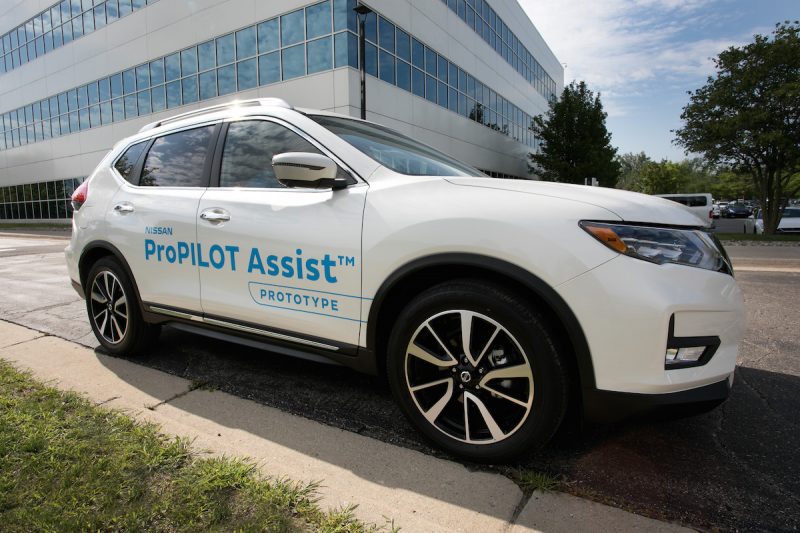Nissan is giving its Leaf a big upgrade in 2018 as the Chevy Bolt and Tesla Model 3 pose greater competition in the electric-vehicle market.
Aside from an expected longer range, the Leaf will be the first vehicle to feature Nissan’s ProPilot Assist. As a level 2 self-driving system, it won’t let you kick back and relax with your hands off the wheel. But it can take over on a highway, even handling incessant braking in stop-and-go traffic.
I recently got a sneak preview of the system on a Nissan Rogue prototype in New York City. Here’s what it was like to use:
ProPilot Assist is a driver-assistance tool that’s meant to take the stress out of highway driving. It’s essentially an advanced cruise control: it keeps the car in its lane even when approaching curves and traffic slowdowns.

ProPilot Assist is powered by a front-forward radar, camera, and sensors. The system relies on clear lane markings to keep the car center on a highway.

The system isn’t without its flaws; it has trouble detecting the contrast between the lane markings and the road in heavy bouts of rain. For that reason, the system will not work if the windshield wipers are on their fastest setting.
ProPilot Assist’s limitations make it strictly a driver-assistance tool. Still, the system is one step toward getting self-driving technology in consumer vehicles, said Andy Christensen, senior manager at Nissan’s Technical Center in North America. The Japanese automaker has said cars won’t be fully autonomous until 2022 the earliest.
ProPilot Assist is a very easy system to use: simply tap the blue button on the steering wheel and set the desired speed by tapping the "+" or "-" signs.

ProPilot Assist will automatically turn off whenever you hit the brake, but you can start it up by pressing the "res" button.
There are two main features to ProPilot Assist: Intelligent Cruise Control and Steering Assist.

Whenever ProPilot Assist is turned on, it will first turn on Nissan's Intelligent Cruise Control system. That means the car can handle stop-and-go traffic but it will not try and steer itself. Steering Assist won't turn on until the car can detect lane markings, which can take a few seconds or minutes depending on the road.
I tested the system on New York's Hudson Parkway for 45 minutes and I can safely say Nissan's Intelligent Cruise Control is an actual dream to use in traffic.

The brake is incredibly smooth. I approached heavy stop-and-go traffic near the George Washington Bridge and the car gracefully paused as we crawled along, intelligently keeping pace with the vehicles ahead without slamming the brake. It was impressive considering how frequently drivers were punching the accelerator only to come to a sudden halt a few seconds later.
I was able to control the space between me and the car in front using the arrows on the steering wheel. Three green lines, pictured here, meant I was opting to leave as much space as possible between me and the car ahead. I could then opt for two lines or one line.

A Nissan spokesperson said the lines did not stand for a specific unit of measurement, but a general indicator of space.
I opted for one line because I was in stop-and-go traffic, however, two lines worked just as well in that scenario. Three lines leaves room for another car to skirt in front, which I imagine is a better option for more open highways. If I were booking down I-95 at 70 mph, I would opt for more space to leave a bit of a cushion for slowing down.
I never felt like I was getting too close to the car ahead, even though I was using the lowest setting.
The beauty of intelligent cruise control is it turned an extraordinarily frustrating task into an easy and somewhat tranquil activity.

I regularly drive the narrow section of Hudson Parkway to the George Washington bridge, which almost always leads to an inevitable traffic jam. The second I approach the slowdown, I feel my blood pressure spike.
But Intelligent Cruise Control took all the stress out of stop-and-go traffic. I never experienced a jarring stop or close call; it paused exactly the way I would want to. Like anyone, I love driving out on an open road with endless sky ahead, but if I can flick on a system to handle the worst aspect of driving, I'm all in.
My experience with Steering Assist was less than ideal, but not poor.

When the feature is activated, a display in the instrument cluster will highlight the lanes in green. If ProPilot Assist can no longer see the lane markers, those green indicators will disappear and a chime will sound. It will automatically re-engage once it finds consistent lane markings.
Steering Assist struggles in scenarios where lane markings are light or even different.

If it's surrounded by freshly-painted, dotted-white lane markers, it is good to go. But if they are faded, it will shut down. That sometimes means the system will turn on and off in rapid succession, which can get a bit tiresome.
It also struggled in lanes where the markings were different, such as solid yellow on one side but dotted-white on another.
From my limited experience, the system fared based in the center lane when it was surrounded by the same lane markings. Still, it does not handle aggressive curves well, so it's important to stay on high alert.

ProPilot Assist can handle gentle curves just fine. I could feel the car steer beneath my hands, which was unsettling at first but easy to get used to.
When I approached an aggressive curve, however, the car's natural instinct was to go flying forward unless I guided the wheel myself. It is not capable of handling sharp curves on its own.
I was a bit disappointed that ProPilot Assist wasn't able to handle steeper curves. I understand that as a driver assistance tool, I have to stay on high alert while the system is activated. But it felt like the feature itself was lacking and, as a result, unnecessary.

I would rather just activate Intelligent Cruise Control and take full responsibility for steering than listen to the system chime on and off, only to struggle when it matters.
I'm also generally uncomfortable using cruise control on sharper curves because the car stays a consistent speed. I would rather brake myself and shut the system off rather than steer a car at 55 mph into an aggressive curve.
As a whole, Nissan's ProPilot Assist still has a long way to go before competing with the likes of Tesla's Autopilot. That's apparent simply by the fact that Tesla's first-generation Autopilot system has more features, like the ability to park itself.

Tesla is also rolling out new Autopilot features throughout the year, such as the ability to automatically change lanes on a highway. Installing that system in the Model 3 gives Tesla a major edge in the electric space.
Still, Nissan's ProPilot Assist is a really nice feature when driving in heavy traffic. Nissan hasn't said how much it will cost, but a spokesperson told me it will be cheaper than Tesla's Autopilot system.
In that case, the Leaf could win out over the Model 3 on price alone. People who order the Model 3 also face a wait time of at least one year, which could be an instant deal breaker for those in the market for an electric car today. If you're looking for a new ride in 2018, it's worth considering the Nissan Leaf, which will be revealed on Wednesday.

